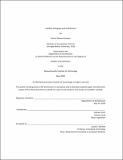| dc.contributor.advisor | Andrew Scott. | en_US |
| dc.contributor.author | Kosovac, Dennis Steven. | en_US |
| dc.contributor.other | Massachusetts Institute of Technology. Department of Architecture. | en_US |
| dc.date.accessioned | 2020-10-08T21:27:00Z | |
| dc.date.available | 2020-10-08T21:27:00Z | |
| dc.date.copyright | 2020 | en_US |
| dc.date.issued | 2020 | en_US |
| dc.identifier.uri | https://hdl.handle.net/1721.1/127848 | |
| dc.description | Thesis: M. Arch., Massachusetts Institute of Technology, Department of Architecture, May, 2020 | en_US |
| dc.description | Cataloged from PDF version of thesis. | en_US |
| dc.description | Includes bibliographical references (page 151). | en_US |
| dc.description.abstract | This thesis seeks to expand Robert Venturi's concept of ambiguity in architecture to include meanings that, extending beyond the formal and semiotic, are rooted in narrative. It takes as a precedent the work of Larry Sultan and Mike Mandel, two artists whose book Evidence explores both formal and narrative ambiguity in photography. This expanded definition of ambiguity evokes the mercurial and conflicting thoughts, feelings, facts, and memories that are at the core of architectural experience yet remain conspicuously absent from contemporary discourse. untitled consists of four books that collectively and equally constitute the thesis. Each book can be intepereted independently or in dialogue with its companions. Braddock, Pennsylvania is a steel town downriver from Pittsburgh, in Allegheny County. The town's dualities are manifest in the narrative tensions between past and present, mind and body, growth and decay. | en_US |
| dc.description.abstract | It is home to the first Carnegie Free Library in the US as well as to the Edgar Thomson Steel Works - one of America's earliest, and still-operating, steel mills. Braddock Avenue runs the length of the town and serves as a mile-long Main Street that encompasses the breadth of the town's vernacular American architectural history. The thesis takes as its site the empty lots along Braddock Ave. that now make up nearly half of the streetscape. Without speculating on the uncertain future of the town's industry, the project engages the divergent narratives of the town by imagining a renewal of Braddock Avenue. A formal strategy of mirroring the existing urban fabric is deployed in an act analogous to the production of photographic images. Where possible, existing buildings are mirrored onto adjacent empty lots; in this act each building is isolated, duplicated, and transformed. | en_US |
| dc.description.abstract | The buildings' bounds are reproduced inversely while their materiality and tectonic languages are replaced by new mass timber structural systems and surfaces. Together with these mirrored forms, the sharply differing color of light reflected on these new materials evokes divergent memories and feelings associated with the work of photographers like Diane Arbus and Stephen Shore, who capture the melancholy, peculiarities and optimism of American urban abjection. The dialectic between the town and the mill is represented by a new community center inserted at the heart of Braddock Avenue, radically skewed on an open site adjacent to the Carnegie Library. This singular anomaly is a distorted mirror of the building forms found in the Edgar Thomson Steel Mill, representing the capacity of mirroring to make architecture participate in an expanding field. | en_US |
| dc.description.abstract | The new building's typology, materiality, tectonics, and programs collectively evoke divergent readings that are at once historic and speculative, sacred and profane. | en_US |
| dc.description.statementofresponsibility | by Dennis Steven Kosovac. | en_US |
| dc.format.extent | 153 pages | en_US |
| dc.language.iso | eng | en_US |
| dc.publisher | Massachusetts Institute of Technology | en_US |
| dc.rights | MIT theses may be protected by copyright. Please reuse MIT thesis content according to the MIT Libraries Permissions Policy, which is available through the URL provided. | en_US |
| dc.rights.uri | http://dspace.mit.edu/handle/1721.1/7582 | en_US |
| dc.subject | Architecture. | en_US |
| dc.title | untitled, ambiguity and architecture | en_US |
| dc.type | Thesis | en_US |
| dc.description.degree | M. Arch. | en_US |
| dc.contributor.department | Massachusetts Institute of Technology. Department of Architecture | en_US |
| dc.identifier.oclc | 1195903481 | en_US |
| dc.description.collection | M.Arch. Massachusetts Institute of Technology, Department of Architecture | en_US |
| dspace.imported | 2020-10-08T21:26:59Z | en_US |
| mit.thesis.degree | Master | en_US |
| mit.thesis.department | Arch | en_US |
